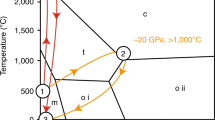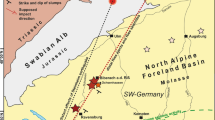Abstract
THE 200-km-diameter Chicxulub structure1–3 in northern Yucatan, Mexico has emerged as the prime candidate for the Cretaceous/Tertiary (K/T) boundary impact crater3–6. Concentric geophysical anomalies associated with enigmatic occurrences of Upper Cretaceous breccias and andesitic rocks led Penfield and Camargo1 to suspect that this structure was a buried impact basin. More recently, the discovery of shocked quartz grains in a Chicxulub breccia3, and chemical similarities between Chicxulub rocks and K/T tektite-like glasses3–6 have been advanced as evidence that the Chicxulub structure is a K/T impact site. Here we present evidence from core samples that Chicxulub is indeed a K/T source crater, and can apparently account for all the evidence of impact distributed globally at the K/T boundary without the need for simultaneous multiple impacts or comet showers. Shocked breccia clasts found in the cores are similar to shocked lithic fragments found worldwide in the K/T boundary ejecta layer7,8. The Chicxulub melt rocks that we studied contain anomalously high levels of iridium (up to 13.5 parts per 109), also consistent with the iridium-enriched K/T boundary layer9. Our best estimate of the crystallization age of these melt rocks, as determined by 40Ar/<39Ar analyses, is 65.2 ±0.4 (1σ) Myr, in good agreement with the mean plateau age of 64.98 ± 0.05 Myr recently reported10. Furthermore, these melt rocks acquired a remanent magnetization indicating that they cooled during an episode of reversed geomagnetic polarity. The only such episode consistent with40Ar/<39Ar constraints is chron 29R, which includes the K/T boundary.
This is a preview of subscription content, access via your institution
Access options
Subscribe to this journal
Receive 51 print issues and online access
$199.00 per year
only $3.90 per issue
Buy this article
- Purchase on Springer Link
- Instant access to full article PDF
Prices may be subject to local taxes which are calculated during checkout
Similar content being viewed by others
References
Penfield, G. T. & Camargo,, Z. A. Soc. Explor. Geophys. 51st Ann. Meeting Tech. Prog. (Abstr.) 37 (1981).
Lopez Ramos, E. Geologia de Mexico, Vol. 2, 2nd edn (Univ. of Mexico, Mexico City. 1979).
Hildebrand, A. R. et al. Geology 19, 867–871 (1991).
Sigurdsson, H. et al. Nature 353, 839–842 (1991).
Smit, J. et al. Geology 20, 99–103 (1992).
Kring, D. A. & Boynton, W. V. Nature 358, 141–144 (1992).
Sharpton, V. L., Schuraytz, B. C., Burke, K., Murali, A. V. & Ryder, G. Geol. Soc. Am. spec. Paper 247, 349–357 (1990).
Izett, G. A. Geol. Am. spec. Paper 249 (1990).
Alvarez, W., Alvarez, L. W., Asaro, F. & Michel, H. V. Geol. Soc. Am. spec. Paper 190, 305–315 (1982).
Swisher, C. C., et al. Science 257, 954–958 (1992).
Quezada-Muñeton, J. M., Marin, L. E., Sharpton, V. L., Ryder, G. & Schuraytz, B. C. Lunar planet. Sci. XXIII, 1121–1122 (1992).
French, B. M. & Short, N. M. (eds) Shock Metamorphism in Natural Materials, 644 (Mono, Baltimore, Maryland, 1968).
Robertson, P. B. & Grieve, R. A. F. Impact and Explosion Cratering (eds Roddy, D. J., Pepin, R. O. & Merrill, R. B.) 687–702 (Pergamon, New York, 1977).
Sharpton, V. L. & Schuraytz, B. C. Geology 17, 1040–1043 (1989).
Stöffler, D. Fortschr. Miner. 49, 50–113 (1972).
Grieve, R. A. F. Geol. Soc. Am. spec. Paper 190, 25–37 (1982).
Lindstrom, D. J. & Korotev, R. L. J. radioanalyt. Chem. 70, 439–458 (1982).
Palme, H. Geol. Soc. Am. spec. Paper 190, 223–233 (1982).
Palme, H., Göbel, E. & Grieve, R. A. F. Proc. 10th lunar planet. Sci. Conf., 2465–2492 (1979).
Duffield, W. A. & Dalrymple, G. B. Bull. Volcanol. 52, 475–487 (1990).
Dalrymple, G. B. U.S. geol. Surv. Bull. 1890, 89–96 (1989).
Dalrymple, G. B. & Ryder, G. Geophys. Res. Lett. 18, 1163–1166 (1991).
Bottomley, R. J., York, D. & Grieve, R. A. F. Proc. 20th lunar planet. Sci. Conf, 421–431 (1990).
Izett, G. A., Dalrymple, G. B. & Snee, L. W. Science 252, 1539–1542 (1991).
Hall, C. M., York, D. & Sigurdsson, H. Eos 72, 531 (1992).
McWilliams, M. O., Baksi, A. K., Bohor, B. F., Izett, G. A. & Murali, A. V. Eos 73, 14 (suppl.) 363 (1992).
Gillot, P.-Y., Jéhanno, C., Rocchia, R. & Sigurdsson, H. C.R. Acad Sci. Paris II 313, 193–199 (1991).
LeBreque, J. L., Kent, D. V. & Cande, S. D. Geology 5, 330–335 (1977).
Izett, G. A. J. geophys. Res. 94, 20879–20905 (1991).
Baker, P. E. Andesites (ed. Thorpe, R. S.) 11–23 (Wiley, New York 1982).
Author information
Authors and Affiliations
Rights and permissions
About this article
Cite this article
Sharpton, V., Brent Dalrymple, G., Marín, L. et al. New links between the Chicxulub impact structure and the Cretaceous/Tertiary boundary. Nature 359, 819–821 (1992). https://doi.org/10.1038/359819a0
Received:
Accepted:
Issue Date:
DOI: https://doi.org/10.1038/359819a0
This article is cited by
-
Chicxulub Crater Joint Gravity and Magnetic Anomaly Analysis: Structure, Asymmetries, Impact Trajectory and Target Structures
Pure and Applied Geophysics (2022)
-
Imaging the Chicxulub Central Crater Zone from Large-Scale Seismic Acoustic Wave Propagation and Gravity Modeling
Pure and Applied Geophysics (2021)
-
Bats and viruses: a death-defying friendship
VirusDisease (2021)
-
Ocean resurge-induced impact melt dynamics on the peak-ring of the Chicxulub impact structure, Mexico
International Journal of Earth Sciences (2021)
-
Seismic attribute analysis of Chicxulub impact crater
Acta Geophysica (2020)
Comments
By submitting a comment you agree to abide by our Terms and Community Guidelines. If you find something abusive or that does not comply with our terms or guidelines please flag it as inappropriate.



